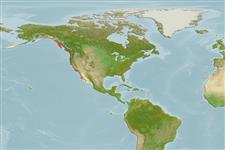Mopalia muscosa (Gould, 1846)
Mossy chiton| Native range | All suitable habitat | Point map | Year 2050 |

|
| This map was computer-generated and has not yet been reviewed. |
| Mopalia muscosa AquaMaps Data sources: GBIF OBIS |
Adicionar o seu Fotografias
Imagem do Google |
No photo available for this species.No drawings available for Mopaliidae.
Imagem do Google |
No photo available for this species.
Classification / Names Common names | Synonyms | CoL | ITIS | WoRMS
| Chitonida | Mopaliidae
Environment: milieu / climate zone / depth range / distribution range Ecologia
; intervalo de profundidade 0 - 5 m (Ref. 290). Subtropical
Distribuição Países | Áreas FAO | Ecossistemas | Ocorrências | Introduções
Eastern Pacific: Alaska, Canada and Mexico.
Length at first maturity / Tamanho / Peso / Idade
Maturity: Lm ? range ? - ? cm Max length : 8.9 cm TL macho/indeterminado; (Ref. 296)
Descrição breve Morfologia
Girdle: Medium wide which is sandy and profusely covered with stiff bristles. Mucro: Highly posterior; depressed. Central areas: Longitudinally ribbed with sharp nodulose ribs transversed with subtle wide obsolete ribs forming a basket weave. Lateral areas: Heavily beaded rib. Inside area: Covered with oval shaped granulations. Color of the valves: Grays to black; rarely, a specimen with blue or orange valves may be found. Color of the girdle: Cream with brownish red bristles (Ref. 296).
Habitat: On rocks, especially in areas of low to moderate surf; found in estuaries (Ref. 315). Depth Range: 0 to 5 m (Ref. 290); middle to low intertidal zones from Alaska to Mexico (Ref. 312). Occurs at the mid tide mark.
Life cycle and mating behavior Maturidade | Reprodução | Desova | Ovos | Fecundidade | Larvas
Members of the class Polyplacophora are mostly gonochoric. Life cycle: Eggs hatch into lecitotrophic planktonic trocophore larvae (no veliger stage) which later metamorphose and settle on the bottom as young adults.
Referência principal
Referências | Coordenador | Colaboradores
Burghardt, G. and L. Burghardt. 2006. (Ref. 296)
Categoria na Lista Vermelha da IUCN (Ref. 130435)
Categoria CITES (Ref. 108899)
Not Evaluated
CMS (Ref. 116361)
Not Evaluated
Ameaça para o homem
Utilização humana
| FishSource |
Ferramentas
Mais informação
Fontes da internet
BHL | BOLD Systems | CISTI | DiscoverLife | FAO(Publication : search) | Fishipedia | GenBank (genoma, nucleotídeo) | GloBI | Gomexsi | Google Books | Google Scholar | Google | PubMed | Árvore da vida | Wikipedia (ir para, procurar) | Registo zoológico
Estimates based on models
Preferred temperature
(Ref. 115969): 9.1 - 18, mean 10.7 (based on 193 cells).
Categoria de preço
(Ref. 80766):
Unknown.


